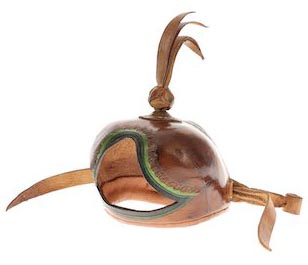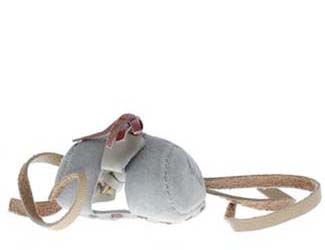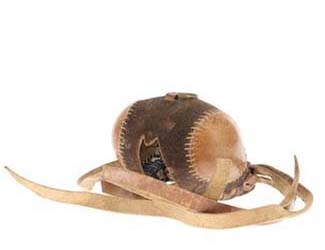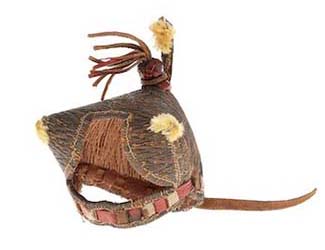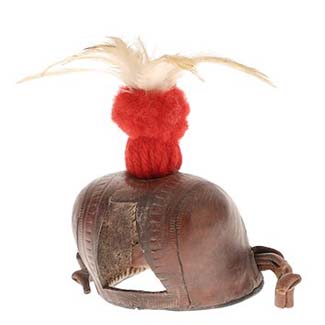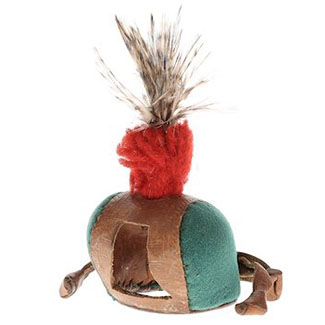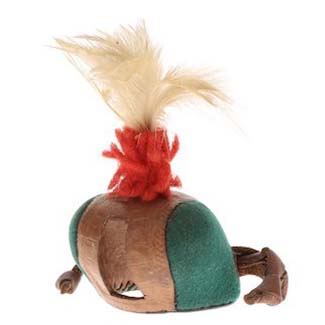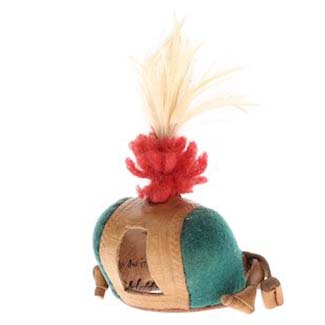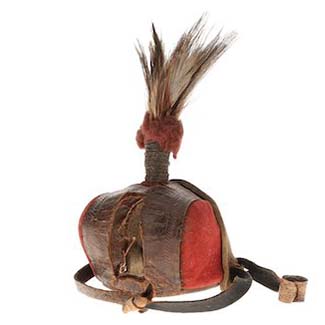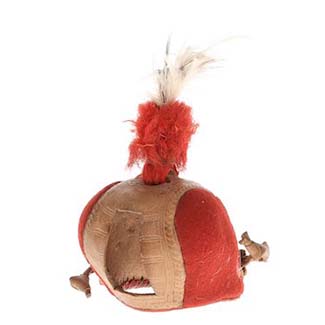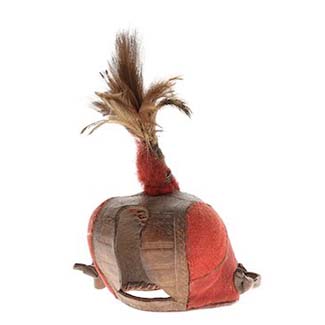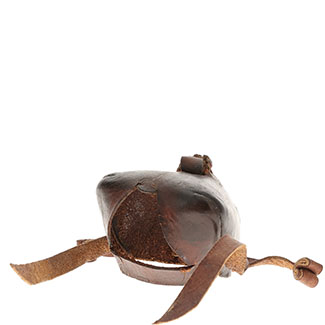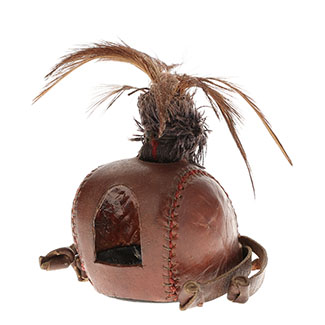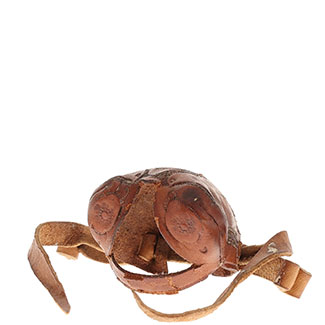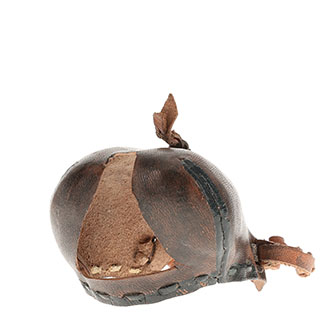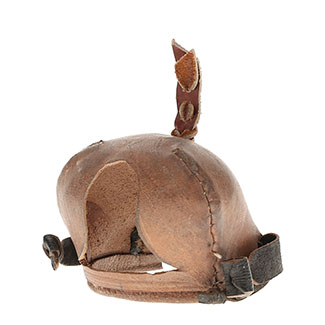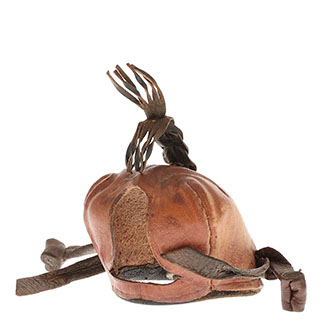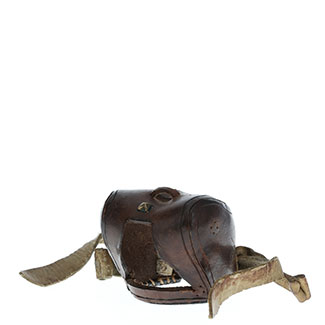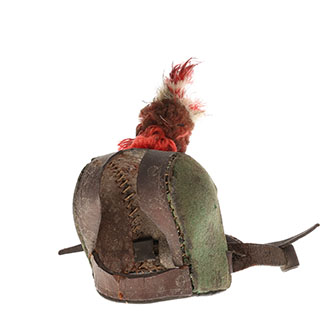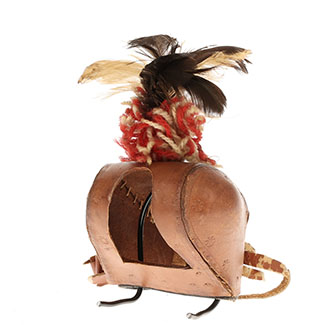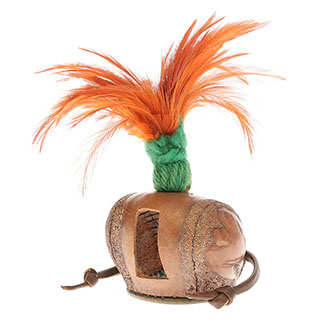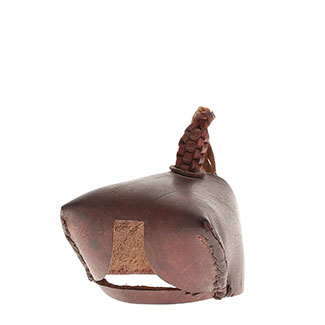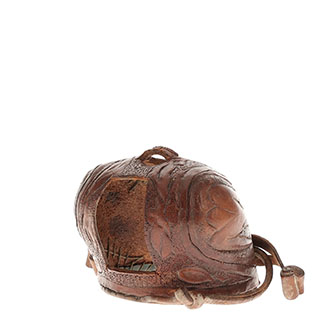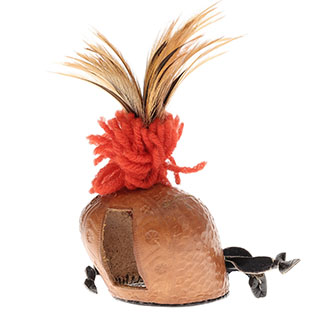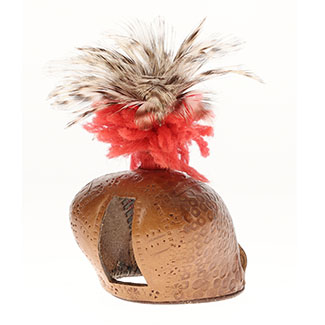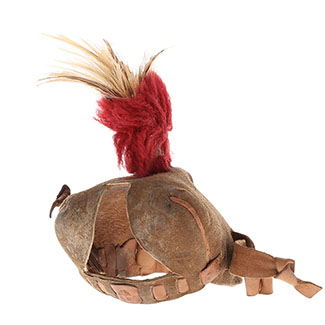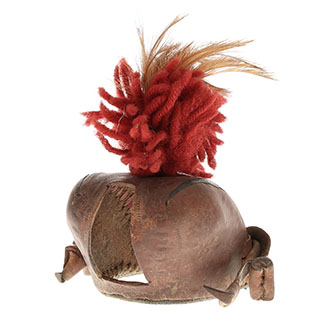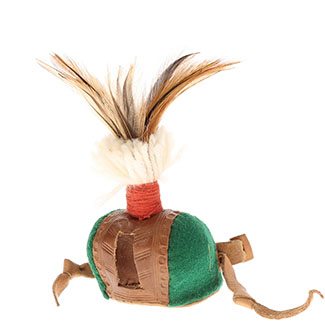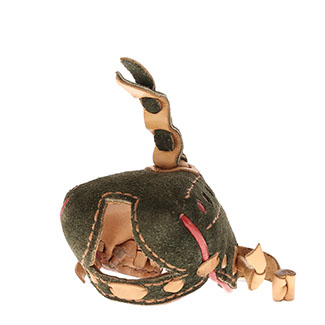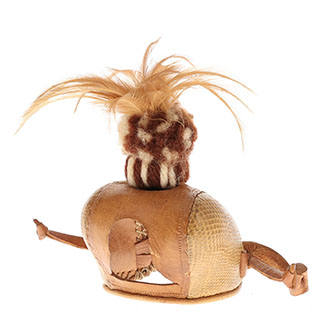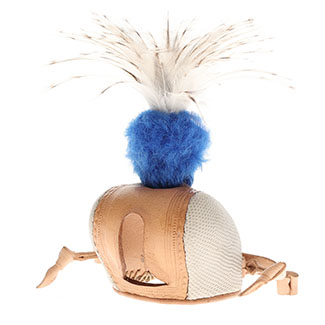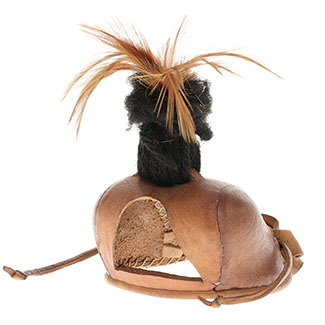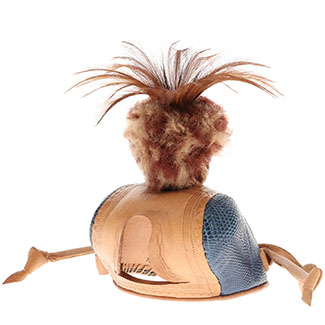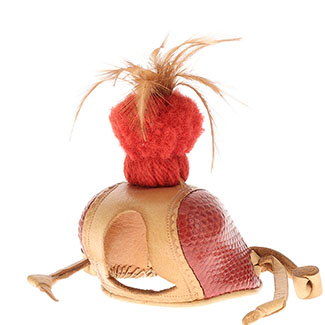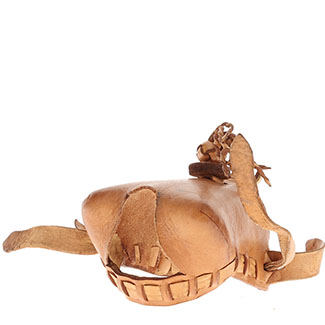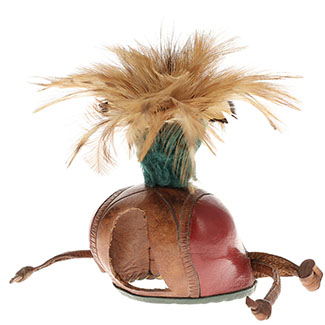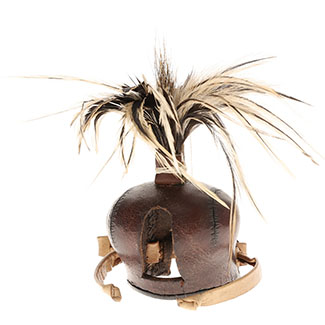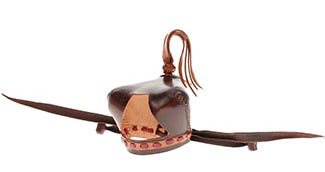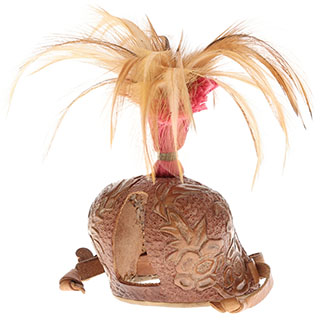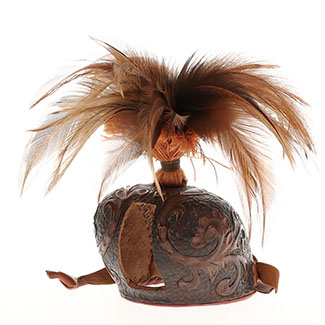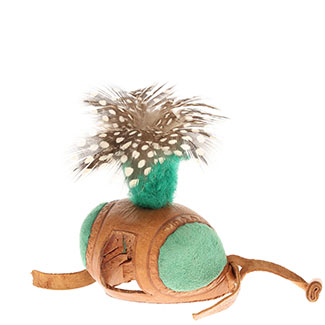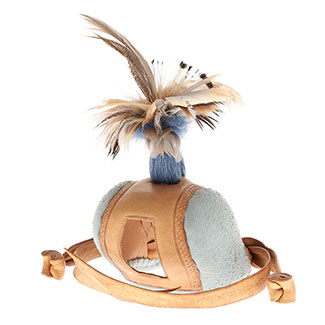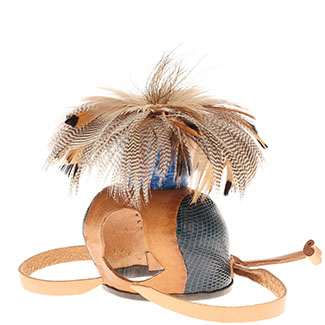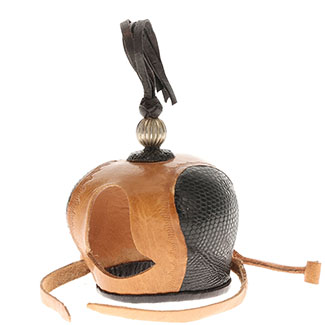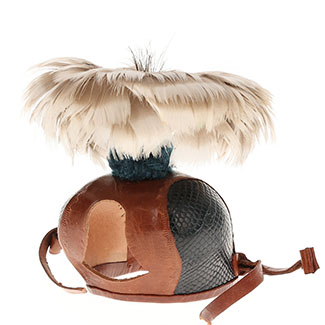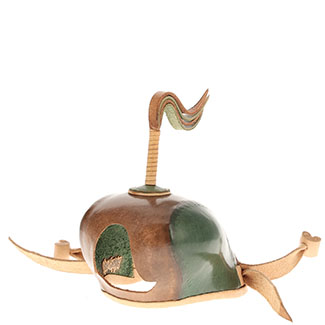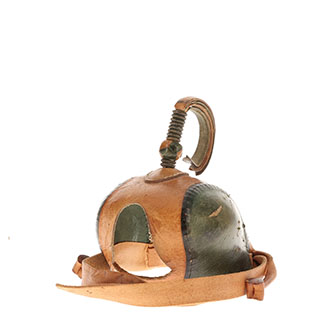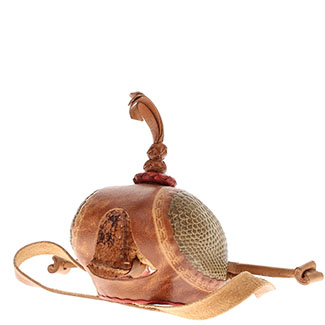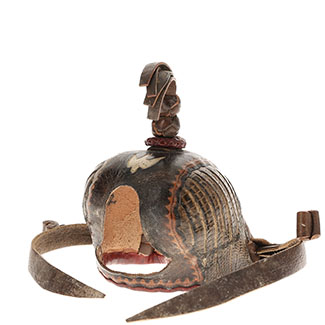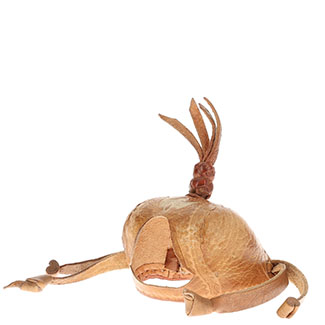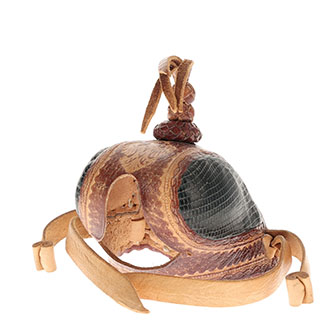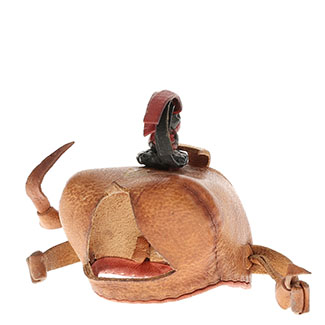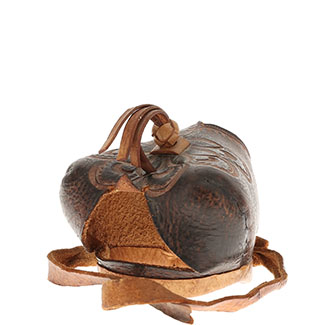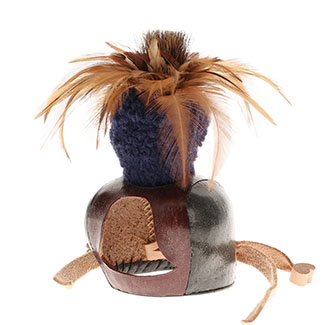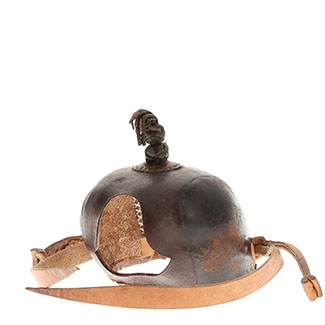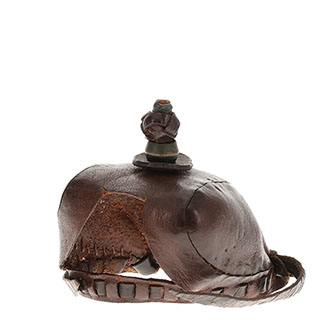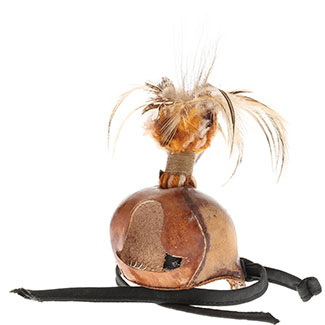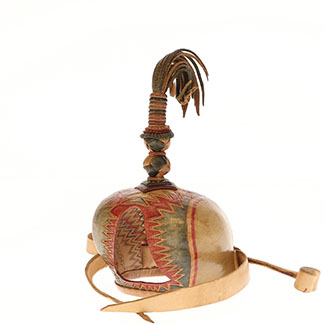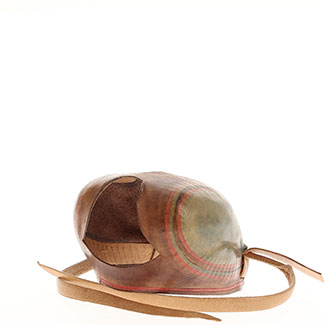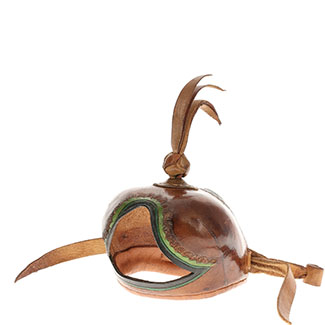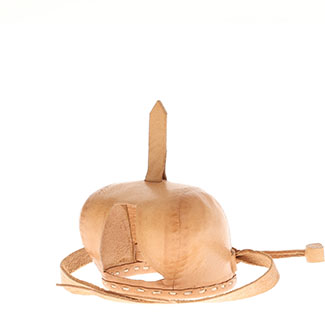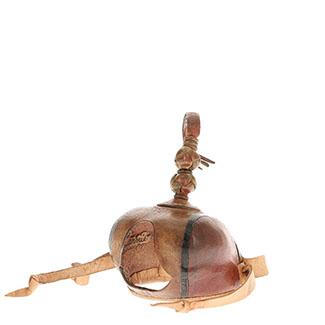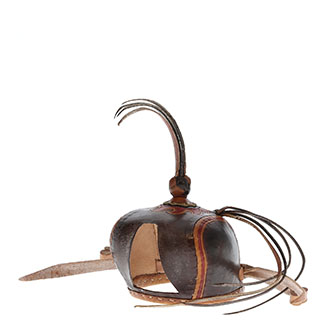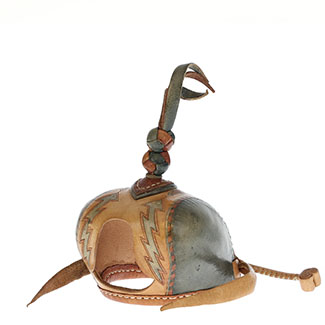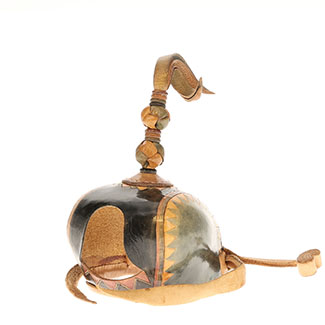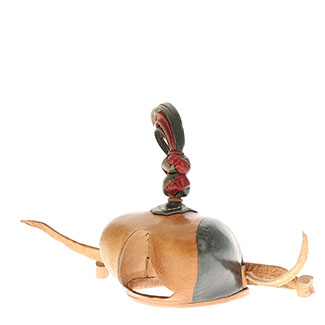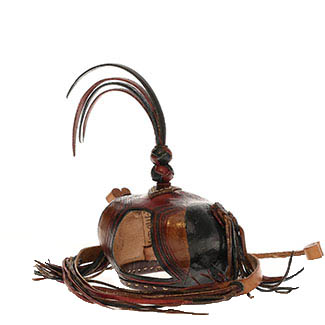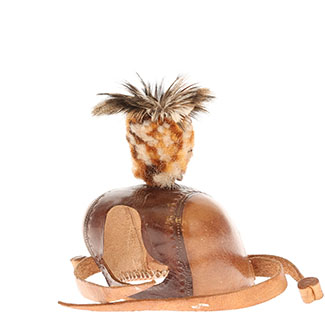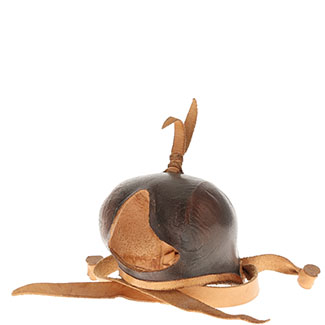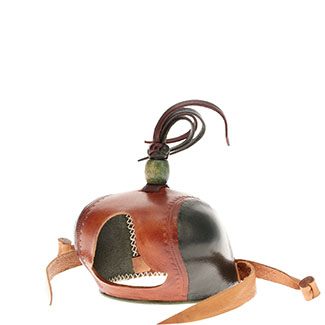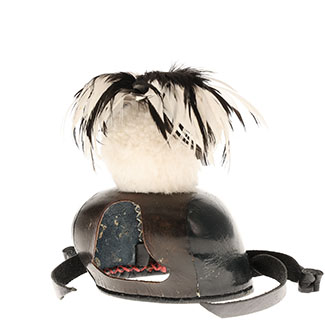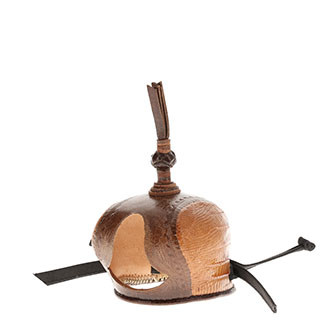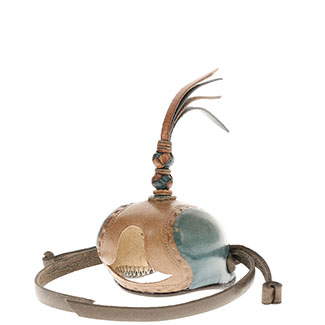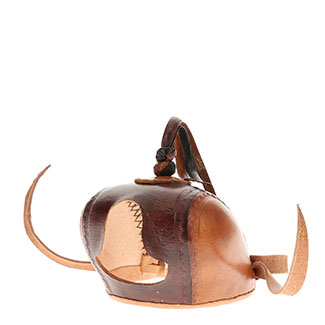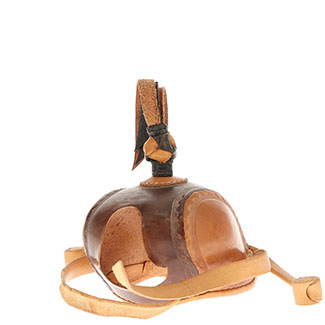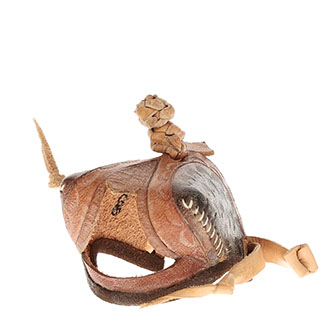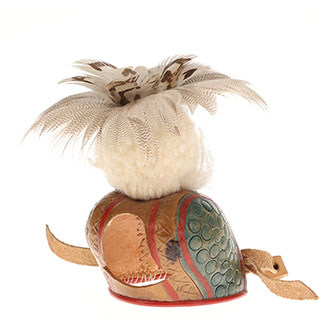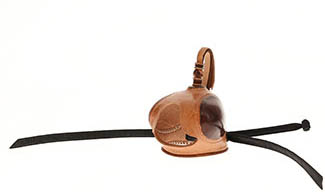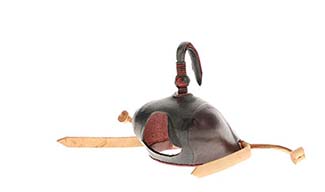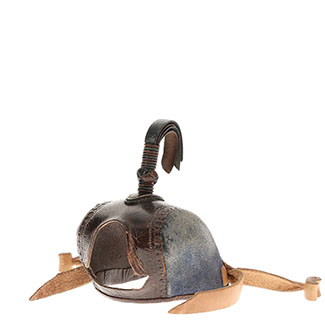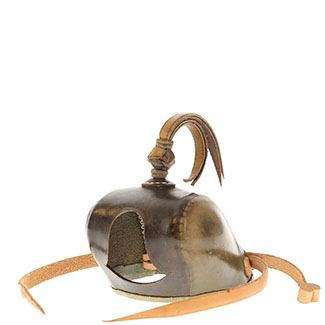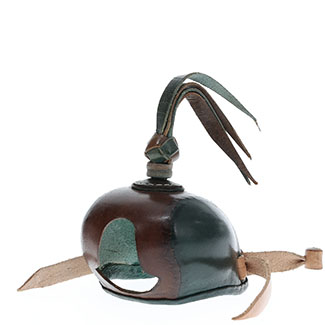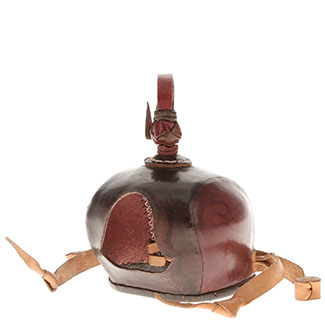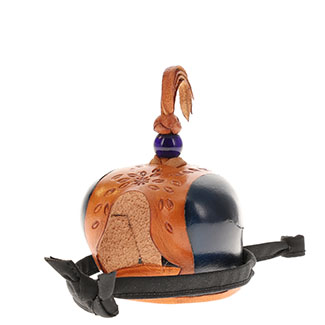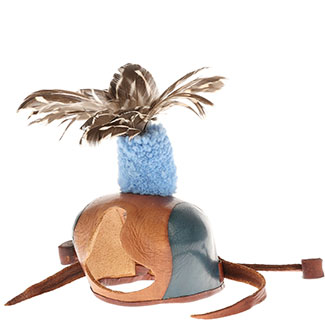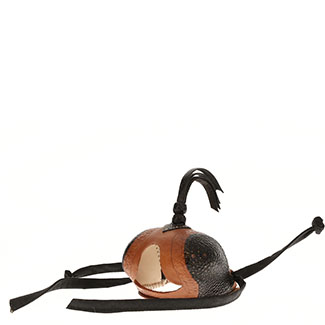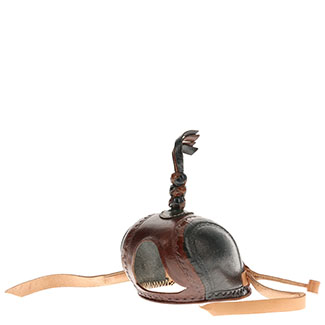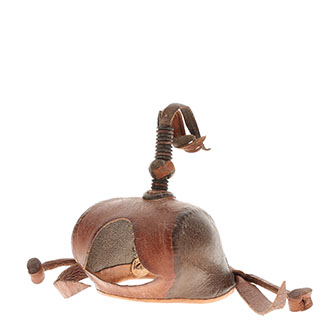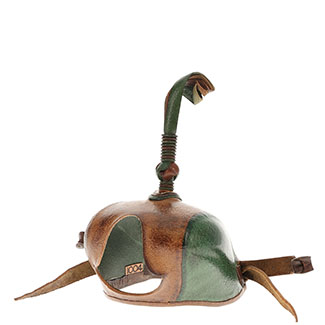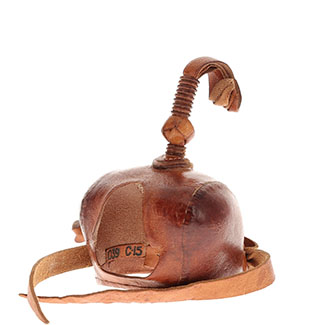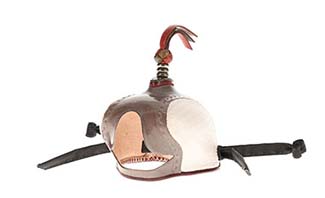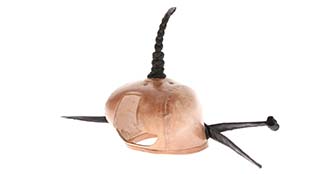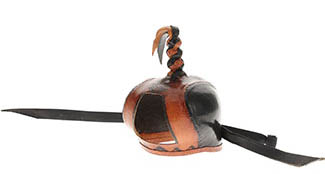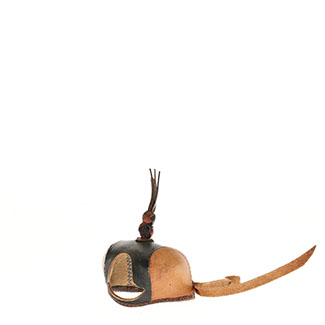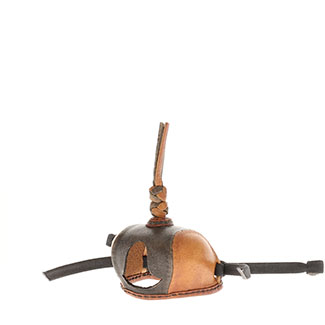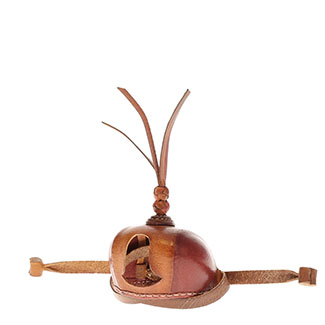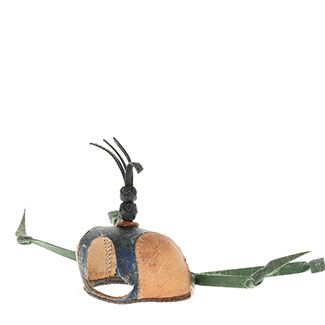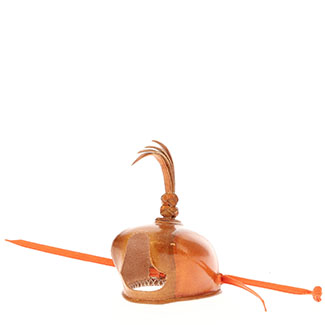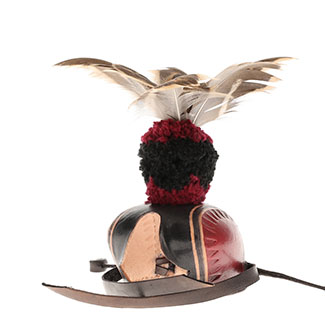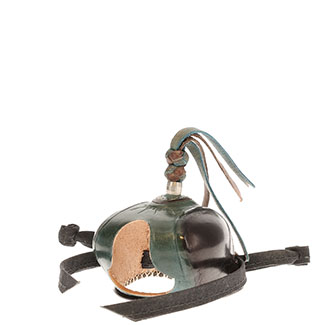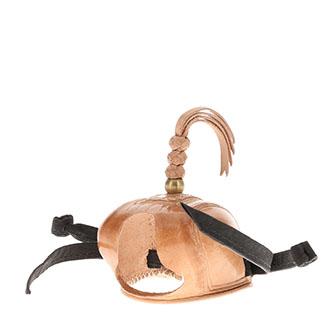Introduction
Watch the Introductory Video

No single item so exemplifies the sport of falconry as the hood. The hood symbolizes both the rich artistry within the falconer community, along with the most practical of ancient tools needed to transport an old gamehawk or settle a freshly acquired passager.
The rapid development and refinement of the hood in North America is the product of both departures from Old World standards and vibrant cross-fertilization among hoodmakers, professional and amateur. Explore the evolution of the “American Hood”.
How to Explore our Hood Exhibit
At the core of this exhibit are dozens of high-resolution 360° scans made as part of our ongoing digitization effort. These are just a sample of the hundreds of hoods in our collection, all of which we are scanning using this technology. You can explore every hood in this exhibit three ways.
1) View an Image Gallery of stills from different angles.
2) Load the 360° Interactive spin which you can turn, tilt, and zoom. These interactive models are large files so they can take a while to load, even with a fast internet connection. To tilt the model down for a better view of the top, use your mouse or finger to "pull" it down significantly and it will switch angles.
3) Click the Object ID to open the collection record and explore deeper into the collection.
1. Status Quo in the Old World
Early hoods across the Eurasian continent included a paper bag-style hood used by Japanese falconers for millennia; a stiff, closed-backed Indian hood requiring some force to affix; or a soft Arab-style hood with a draw-string — all indispensable aids to the management of hawks, falcons, and eagles alike.
Traditional Hoods from the Middle East and Asia
Over centuries, European hoods transformed from their Arab antecedents to a carefully stitched three-piece hood, molded over a wood or metal form, and closed by braces. As reflected in the products of Valkenswaard's Mollen family, these rigid hoods retained their shape, and offered needed space around the falcon’s eyes. But unlike their Arab counterparts, they were heavy, with an unyielding, abrasive rectangular beak-opening through which a falcon could often not cast.
By the 1920s and 30s the "standard" for American hoods was still the Dutch-style hood made by the Mollen family, however the supply ended following the death of Karel Theodore Mollen in 1935.
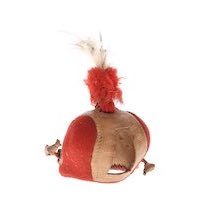
Click on the maker's name below to open a virtual collection cabinet of their work.
-
Karl T. Mollen
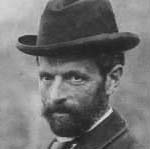
Last survivor of the famed Mollen family of professional falcon trappers and hawk furniture makers of Valkenswaard in the Netherlands - died ca. 1936. Family for generations was associated with high-quality falconry (Loo Hawking Club), a reliable source of autumn-caught Peregrines (supplying Britain's Old Hawking Club), and for the epitome of Dutch-style hoods with which their name became synonymous.
2. Early American Craftsmen 1930’s – 1940’s
In the 1930s, a few Americans began to make and sell Dutch-style hoods based on European standards. Many retained the drawbacks of the heavy, stiff Mollen hoods yet without their refined craftmanship. The first of these was L. N. (Larry) Wight, a shop teacher who supplied fellow members of Philadelphia's Peregrine Club.
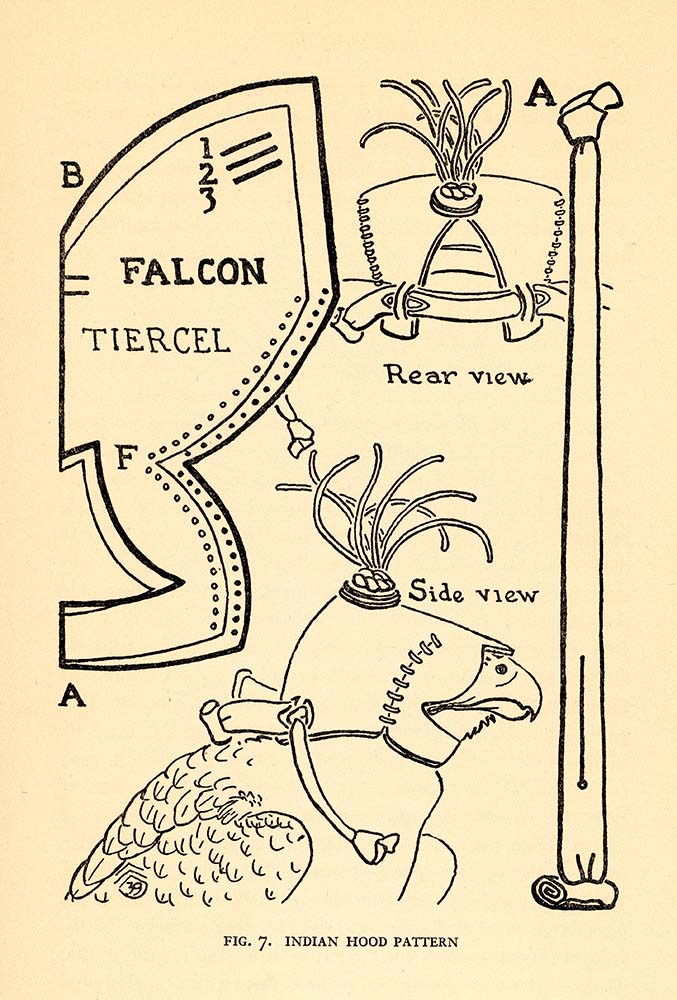
From Falconry: A Handbook for Hunters by Bill Russell.
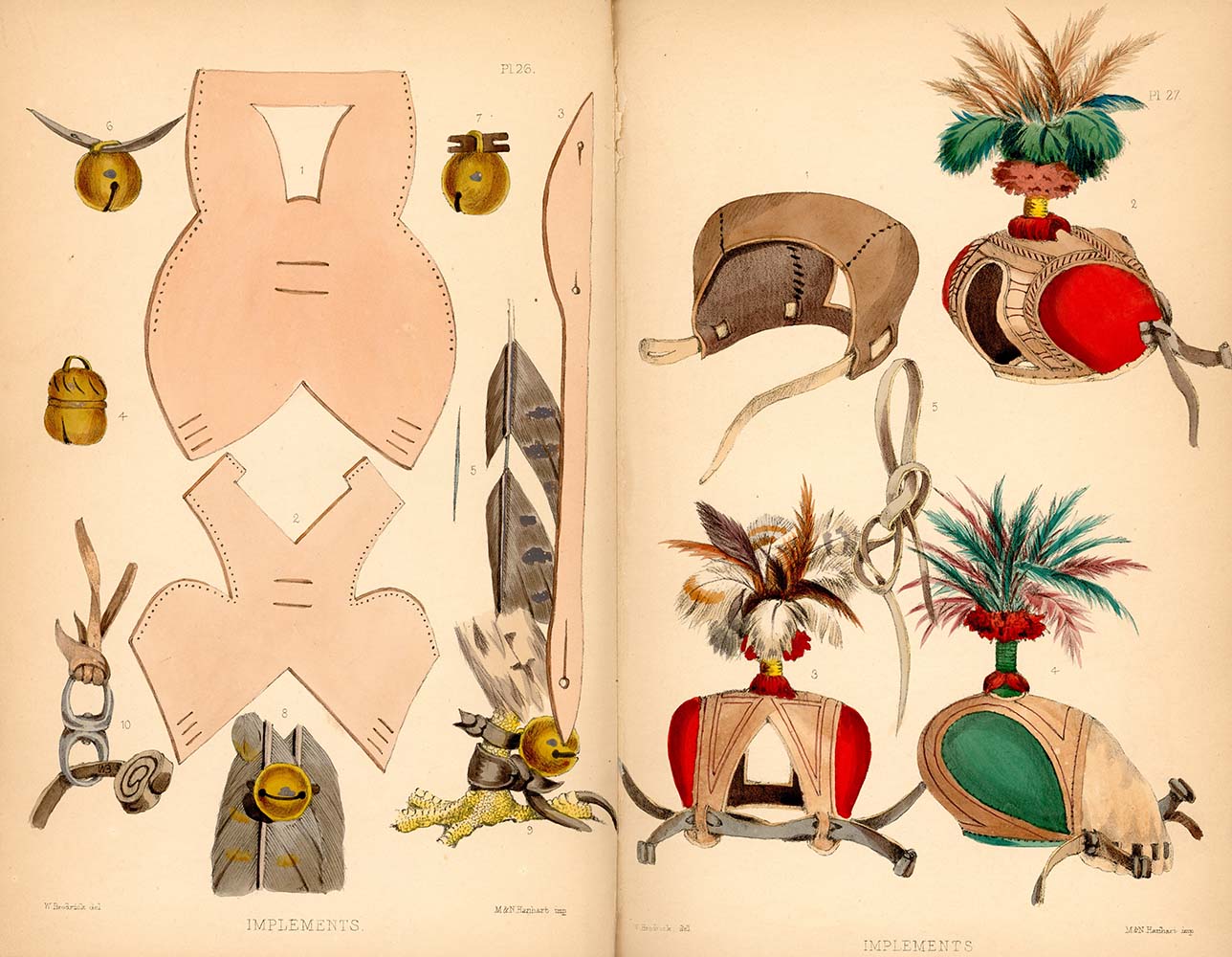
From Falconry in the British Isles by Salvin & Brodrick.
New momentum emerged in 1940 with the publication of the first American falconry book, Falconry: A Handbook for Hunters by Bill Russell. Russell’s book included a pattern for a modified (by the addition of Dutch-style braces) Indian hood, a style referred to as "Anglo-Indian." Such hood patterns had been depicted much earlier by Salvin & Brodrick (1855) in their Falconry in the British Isles, however few British falconry publications were commonly available in the US.
The style involved a simple one-piece construction without a block or “form” and offered a wide, smiling beak-opening that did not chafe and allowed the bird to cast. Aspiring American hoodmakers now had the necessary resources to launch their craft.
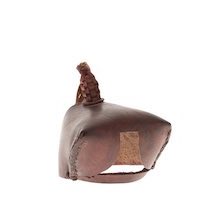
Click on the maker's name below to open a virtual collection cabinet of their work.
-
Russell "Luff" Meredith
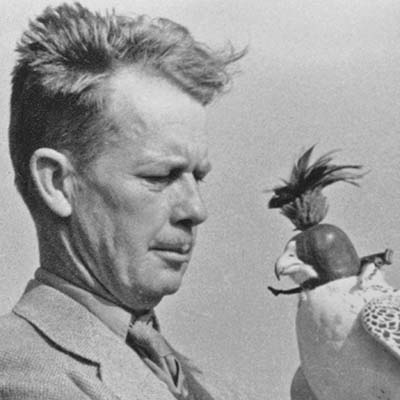
Russell Luff Meredith is often acknowledged as "The Father of American Falconry". He was a leading proponent of the sport in its development in the early decades of the 20th Century. A source of both advice and information, his own practice of hawking in the field was limited by his many years in the eastern US, constraints of a military aviator's career, and a severe encounter with a propeller that side-lined active military duty for many years. Through those years he set an example of ethics and propriety in the sport. A long-time gadgeteer, his major contribution to hood-making was description of a pattern for a modified Anglo-Indian hood (Falconry News and Notes;1(2):14-18). Others carried that patten forward into iterations that enhanced development of an American-style Dutch hood.
-
Jim Fox
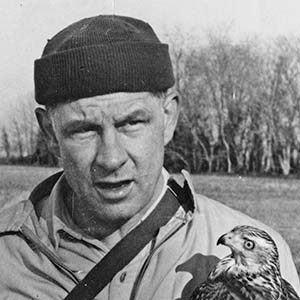
A Washington DC falconer and close associate of Alva Nye. Most known for his goshawk-ing activities, Fox also trapped for many years on the ridges west of Washington. An exceptional craftsman, he was said to cope a hawk "better than God." As a hoodmaker, Fox was an early proponent of molding hoods made from Luff Meredith's Anglo-Indian 1954 hood pattern over Dutch style forms. The hoods so produced had a significant impact on subsequent Dutch-style hoods made by a newer generation of American hoodmakers.
-
Lawrence Wight
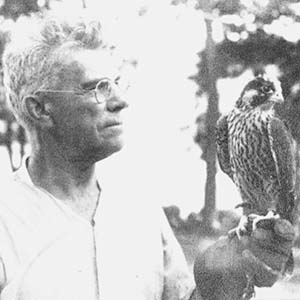
A member of Philadelphia's Peregrine Club, Wight began making falconry equipment in the mid-1930’s when equipment was otherwise unavailable except from abroad. Although ostensibly modeled on imported Mollen hoods, Wight's standard of workmanship failed to live up to the quality of the Dutch originals. He continued his efforts for many decades but he was soon surpassed by a growing corps of American craftsmen.
-
Larry Zuk
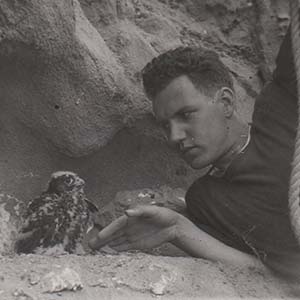
A student and friend of Robert Stabler, Larry Zuk was a serious, dedicated falconer. In his college days in Pennsylvania he attempted to copy Mollen hoods in the hands of local falconers but seemingly only pursued that endeavor for his own needs and did not follow it subsequently. Following naval service in California during World War II, he drove cross country visiting numerous falconers en route. Particularly struck by pheasant numbers outside Denver he returned and settled there, actively pursuing game hawking with bell maker Pete Asborno.
3. Emerging Artisans & Refining Patterns 1950’s – 1960’s
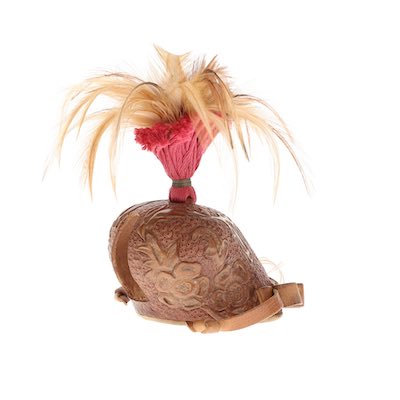
Based on contacts developed during WWII, U.S. falconers began to obtain well-made hoods from German maker Otto Kals, and particularly fine Dutch-style hoods made in France by Henri Ondet - both influencing several Americans. Lou Woyce, Minard Stevens, and Bob Widmeier emulated their favorite European mentors, and on their heels, the exceptional craftsman Brian McDonald emerged as the leading commercial hoodmaker in the U.S. Known for his fine Dutch hoods, McDonald also made exquisitely tooled Anglo-Indian hoods.
In January 1954, Luff Meredith published a pattern in Falconry News and Notes, for a further-modified molded Anglo-Indian hood; one with an essentially square (flat) bottom. Soon after, Widmeier published a detailed article describing how to make a 3-piece Dutch hood, following lessons from his friend, California falconer Minard Stevens. In 1959, Falconry News and Notes reprinted, the Dutch falconer H. J. Slijper’s article describing a tailor's "canon" for an Anglo-Indian hood - a means whereby various sizes of a basic hood pattern could be produced by application of a mathematical formula. By the 1960’s American falconers had tried and true patterns and instructions. The craft was poised to blossom.
-
Otto Kals
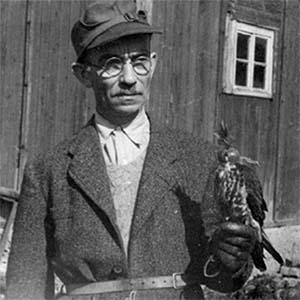
A German professional falconer closely associated with Renz Waller, Kals was first introduced to American falconry circles when referenced in Bill Russell's 1940 falconry book as a source of falconry furniture. His hood pattern and standards highly influenced Minard Stevens, resulting in the first quality Dutch hoods made in N. America. Stevens and several other American falconers purchased Kals' fine pencil drawings helping him survive the vicissitudes in Germany following World War II.
-
Brian McDonald
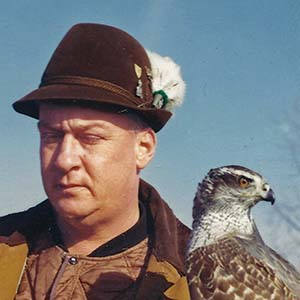
Brian McDonald was a master craftsman, accomplished in a variety of media. Close to Washington DC falconer T. Halter ("Dusty") Cunningham, the two trapped Peregrines together on the beaches of Assateague Island in the years following World War II. From those experiences the two came up with the American version of a leather, noose-bearing harness that has been a staple in American trapping ever since. With his skills, McDonald turned to hood-making and became America's first national-level commercial hoodmaker, offering both Anglo-Indian hoods and the modernized Dutch-style, made over forms of his own making. Along with Lou Woyce, he is credited with advancing the “smiling” beak opening in Dutch-style hoods.
-
Andre-Henri Ondet
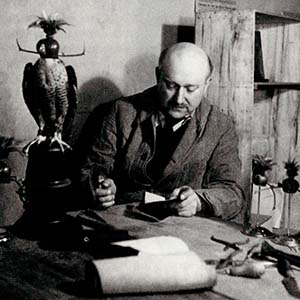
A French professional saddler, not a falconer, Ondet was encouraged my members of the French falconry community and became recognized as a maker of high-quality Dutch-style hoods. Ondet was introduced into American falconry circles through his association with Philadelphia falconer Cornelius ("Corny") McFadden during the latter's European service in World War II. McFadden inspired hoodmakers including Bob Widmeier, Doug Pineo and Lou Woyce, with examples of Ondet hoods. Their standard had a recognizable effect on the quality of hoods produced in the United States in subsequent years.
-
H.J. Slijper
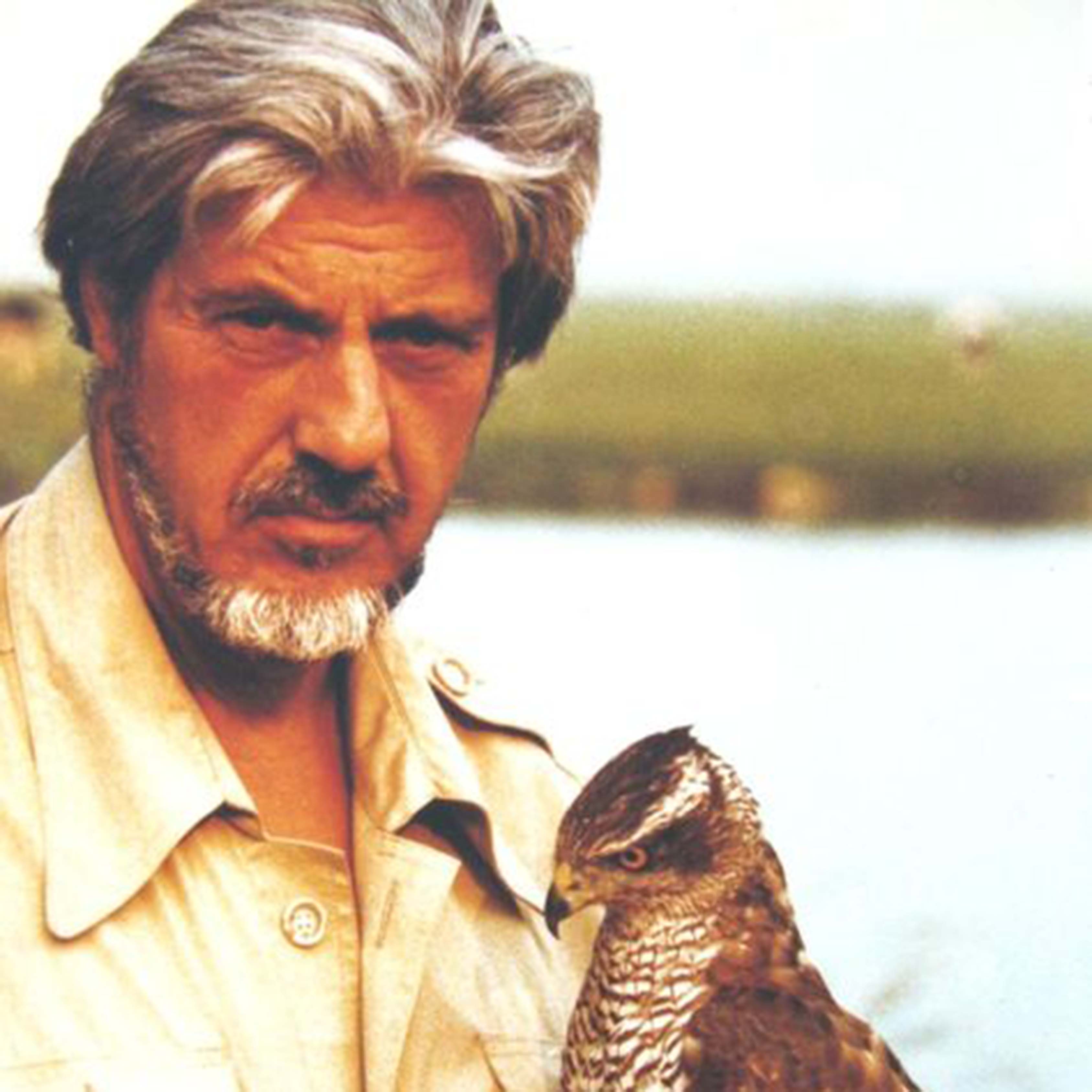
H. J. Slijper was a Dutch artist and hoodmaker who came to the attention of Americans when he published a detailed article proposing a tailor's "canon"-type formula by which Anglo-Indian style hoods could be made to fit utilizing a basic measurement of the breadth of the hawk's head. While not uniformly consistent, hoods made using his formula fit well and were used in the U.S. for several years following appearance of the article.
-
Minard Stevens
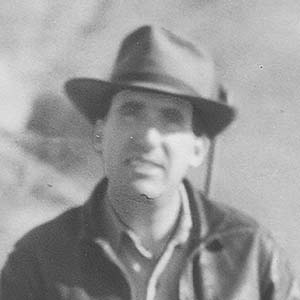
Texas-born California falconer practicing until the advent of World War II, Stevens hawked during an era when most were holding birds more than hawking. Both before and following WWII, Stevens became an accomplished maker of fine Dutch-style hoods, little recognized however, due both to his retiring nature and higher pricing ($15) compared to the competition then under $10. Later in his career, falconers were impressed by his hoods after his wife Gladys ("Dirk") carved intricately beautiful designs on their exteriors.
-
June Woodford
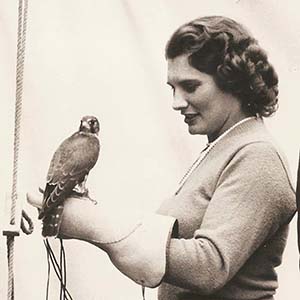
June was a British veterinarian whose interest in hoodmaking was sparked by her falconer-spouse who was also the Secretary of the British Falconers' Club. Her hoods were particularly well made and of stylish appearance, yet retained the heavy stiffness of the classic Dutch hood together with its rectangular beak-opening. Her attendance at NAFA's 1963 field meet introduced her hoods to an American clientele. However American falconers were more and more drawn to locally produced, lighter-weight hoods featuring the new "smiling" beak-opening.
-
Lou Woyce
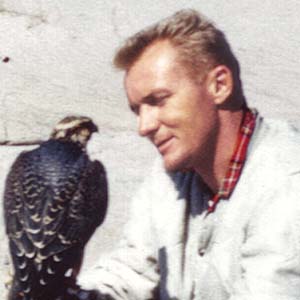
A Maryland falconer, Lou Woyce grew up in falconry as one of Corny McFadden's disciples. Among other talents, Lou was assigned (by McFadden) as a hoodmaker for the group. With his own considerable skills, and using as examples Ondet hoods supplied by McFadden, Lou became one of a small group making excellent Dutch-style hoods, continuing to improve over the years. He and Brian McDonald, led the development of a bell-shaped ("smiling") beak opening, designed to fit the contours of the falcon's beak, thus making for a far-more comfortable (and acceptable – to the bird) hood.
4. The American Renaissance: 1970’s – 1990’s
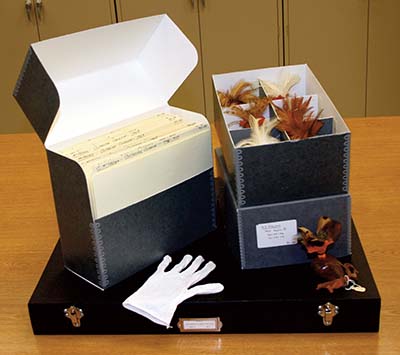
By the mid-1970s Brian McDonald had slowed down his hood-making and several talented prospects emerged including Bob Martin and Doug Pineo. Influenced by Ondet hoods and Lou Woyce, Pineo began crafting excellent Dutch-style hoods employing the smiling beak opening with great skill. Pineo soon became prolific and, still active today, would achieve the longest tenure of any commercial hoodmaker in North America.
In this same period California falconer John Moran established new standards with his refined Dutch-style hoods. Moran was strongly influenced by Bob Martin, and although highly acclaimed for the art decorating the side panels of his hoods, the real attractions to Moran's hoods were their excellent fit and the high standard of craftsmanship. Not readily recognized, Moran's early Dutch hoods were made on the Meredith pattern noted above.
Moran's craftsmanship was infectious, and a flurry of high-quality hoods began to appear by such competent craftsmen as Gene Johnson and Dave Current. Gene's artistic abilities extended far beyond his hoods, including painting, fine leatherwork, and even knife-making. Dave Current set an example (as well as a basic hood shape) that was then followed by many upcoming hood-makers.
-
Dave Current
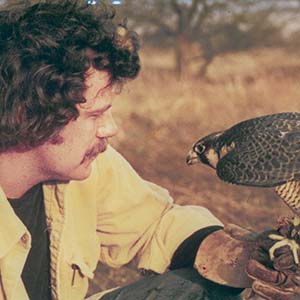
An Illinois falconer, Current was a close friend of Ed Fitch who he accompanied on hawking excursions to Nebraska as American falconers began to seek high quality quarry further from home. Although lesser known among contemporary hoodmakers, his finely made Dutch-style hood inspired many.
-
Gene Johnson
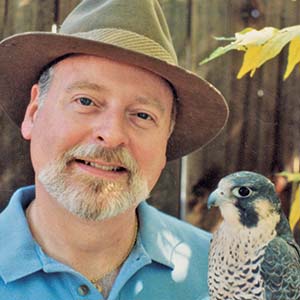
Gene Johnson was a falconer, artist, and falconry equipment maker of rare talent. He graduated from Ohio State University in 1970 with a degree in Wildlife Management and served in the United States Air Force as an ICBM Missile Launch Control Officer during the Vietnam War. At Wichita State University and Kent State University, he studied Fine and Graphic Arts, Arabic, Sculpture, Jewelry Making and Metal Sculpture in the form of knife making. Gene was recognized as a premier hood-maker in the eastern side of the US in the late 60’s and 70’s then later moved to Colorado. He is recognized as the first U.S. hood-maker to incorporate the Arab accordion-style back in a 3-piece Dutch-style hood. Seeking to capitalize on a potential Arab market he made use of Arabic script in advertising. The quality of his hoods attracted the affirmative attention of Sheikh Zayed Bin-Sultan al Nahyan as early as 1976 at the first International Conference on Falconry and Conservation hosted by that U.A.E. leader. Many of his later hoods had a maker’s mark of a falcon above the beak opening.
-
Bob Martin
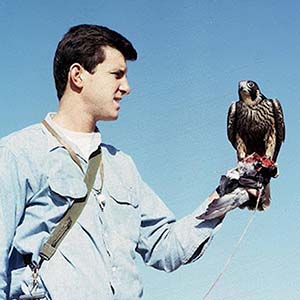
A California falconer, Martin was of considerable skill both with a hawk in the field and at his hoodmakers bench. In Southern California's aero-space industry he had learned the intricacies needed to shape the wooden block for his hoods. Coming in the aftermath of McDonald hoods, some considered Martin hoods heavier, which they were to a degree, but their fit was exemplary. His patterns and blocks were heavily influenced by Ondet. Martin's output went mostly to local friends, never receiving the notoriety they deserved.
-
John Moran
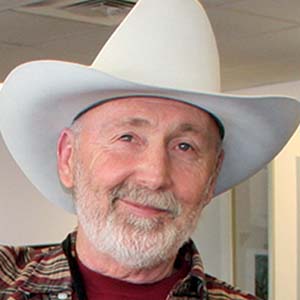
Considered an inspiration by many contemporary hoodmakers, Moran was known for both the exceptional fit of his field hoods and an unparalleled level of artistry displayed in show pieces. Moran grew up in Pennsylvania where he received some formal art training before moving to California. He started making Anglo-Indian hoods over a block but was introduced to making the 3-piece Dutch-style hood by California falconer, and hoodmaker, Bob Martin. Later he moved to Colorado where he was influenced by Jack Stoddart. Before long, Moran began to refine his patterns and achieved a high reputation of exceptional fitting hoods. While some decorative hoods easily exhibit his artistry, others have concealed miniature paintings in the inside eye-panels.
-
Doug Pineo
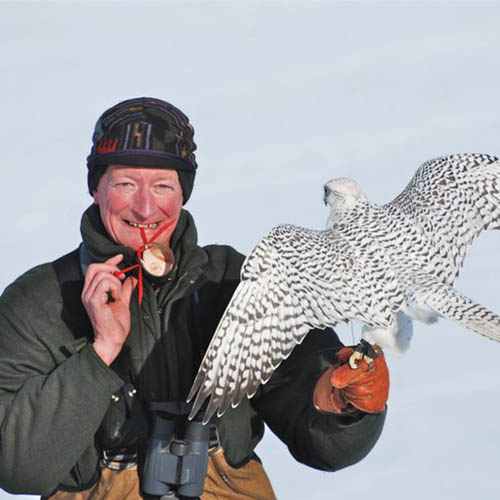
Doug Pineo is the longest running falconry equipment vendor in North America. Doug also worked concurrently as a full-time wildlife biologist/ecologist for Washington Department of Fisheries and Wildlife (retired). He is an active supporter and volunteer for many conservation groups and falconry organizations. Doug published his first falconry equipment price list in 1968, and while he is known for the quality of his equipment generally, his Dutch hoods are widely regarded in North America and internationally, for their quality and fit.
By the 1980’s and 90’s, a new assemble of craftsmen emerged including Chad Cyrus, Gerald Geiger, Ray Gilbertson, Robert Helsom, Tom Maechtle, Jim Nelson, Ron Rollins, Clayton Smith, Steve Tait, Pete Watzke and more.
Several other highly talented hoodmakers devoted their artistry to meeting their own needs, and that of hawking friends, rather than commit to all-out commercial production, including Jim Ince, Rob Coleman, Bob Berry, and Art Tawatari, to name a few.
By the mid-1980s the purchased Dutch hood appeared to have surpassed the self-made Anglo-Indian as the hood of choice for virtually all falconers who could afford them. By the late 1990’s falconers had a large selection of fine American hoodmakers from whom to choose.
-
Bob Berry
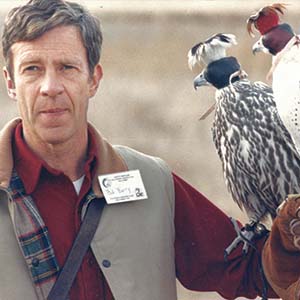
Bob Berry is a raptor conservationist and cofounder of the The Peregrine Fund. He is also known for his role developing falconry telemetry. As a hoodmaker, he initially received instruction from Lou Woyce and then later Chad Cyrus. Never delving into commercial production, his hoods were primarily intended for personal use or given to friends.
-
Rob Coleman
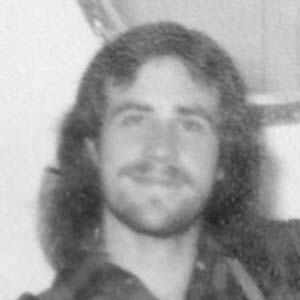
The son of a California falconer, the late Rob Coleman showed tremendous artistic talent at an early age. Coleman’s paintings are prized by falconers and while he never made hoods commercially, and produced modest numbers, his elegant hoods reflected his natural artistic ability.
-
Chad Cyrus
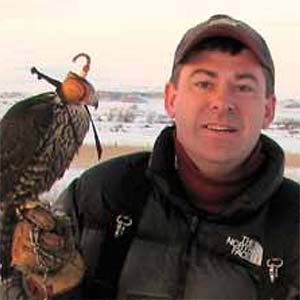
A native of Montana, the late Chad Cyrus advanced as a falconer under the influence of Pete Widener, the Mutch brothers, and Dan Konkel. He began making hoods as a teenager and was later mentored by Gerald Geiger. Cyrus sculpted his own blocks without copying others and sold hoods commercially for many years until his untimely death in 2011.
-
Gerald Geiger
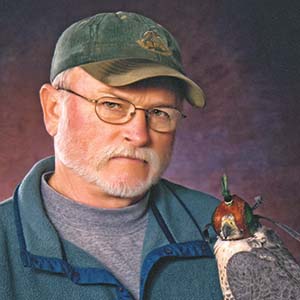
Gerald Geiger was a born in the prairie region of Glendive, Montana but relocated to the Missoula area where he became a falconer. He worked in the railroad industry while flying passage falcons and goshawks. He later relocated to the “Hi-line” and expanded his breeding project, focusing on Peale’s peregrines and occasionally gyr-hybrids. Mastering many dimensions of falconry, Geiger is known for his gamehawking acumen, fine setters, peregrines, and excellent falconry equipment including elegant hoods. Although Geiger never delved into significant commercial production, he mentored hood-makers such as Chad Cyrus and Ray Gilbertson.
-
Ray Gilbertson
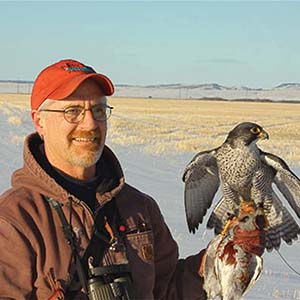
Gilbertson entered falconry in the Missoula area under the influence of falconers such as Pete Widener and Gerald Geiger, the later mentored him as a hoodmaker. Along with fellow Montana falconer-hoodmaker Clayton Smith, Gilbertson’s hoods reflect an extremely high standard of craftsmanship.
-
Jim Ince
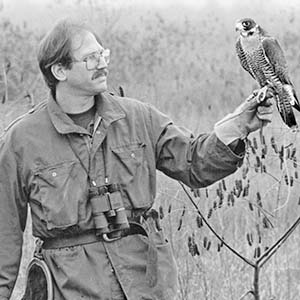
A highly skilled falconer, hoodmaker, bell-maker, and overall master-craftsmen, Ince was influenced by hoodmakers Brian McDonald and Bob Martin. He produces a lightweight finely made 3-piece Dutch-style hood with exacting stiches and nicely shaped beak opening. Ince primarily produces hoods for personal use and friends.
-
Tom Maechtle
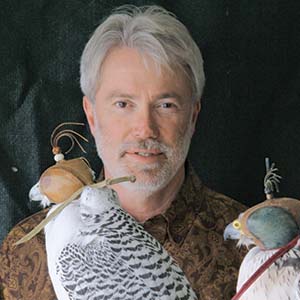
Tom Maechtle was a wildlife professional who worked as a field biologist for The Peregrine Fund - a career that began as a teenager. He eventually gravitated to hoodmaking while surrounded by numerous experienced falconer-biologists who gave him tips and feedback. Maechtle produced hoods commercially for several years. He acknowledged instruction from Dave Current as an important factor in his development.
-
Jim Nelson
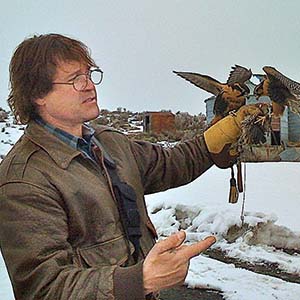
A Northwest falconer, Nelson spent several years as a schoolteacher in rural Alaska. Jim was instrumental in identifying the l’Alethe, a mystery bird used in 17th Century European partridge hawking, as the Aplomado Falcon, imported from the New World. Nelson developed a new "darted" pattern allowing construction of a seeming Dutch-style shaped hood without the use of blocks over which to mold them. He is the author of the book Hoods, Hooding, and Hoodmaking (2016).
-
Ron Rollins
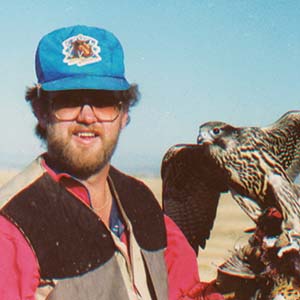
Ron Rollins made fine Dutch-style hoods and blocks for many years. He was initially influenced by falconer-hoodmaker Mike Bradford. In the 1990’s Rollins produced a video on hoodmaking that made a major impact on a new generation of hood-makers, by revealing nuanced techniques and adding encouragement. Previously, awling techniques and the finer points of cross-stitching remained a secret to many would-be hoodmakers.
-
Clayton Smith
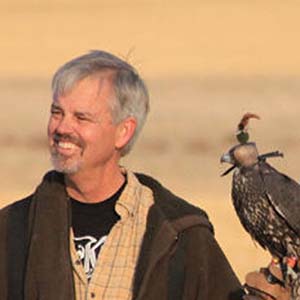
Named as a primary inspiration by many contemporary hoodmakers, Clayton Smith set an exemplary standard by 1980’s and 90’s. Smith modified his forms to include a beak bulge forming a molded beak opening. Compared to many contemporaries, he was able to produce a notably lightweight hood utilizing relatively thin leather and immaculate stitching. He formed sleek, finely made topknots and developed a “posi-lock” brace system that closed with an audible “snap”. Although he left commercial hoodmaking by the 1990’s, many regard Smith as one of the top hoodmakers in America.
-
Steve Tait
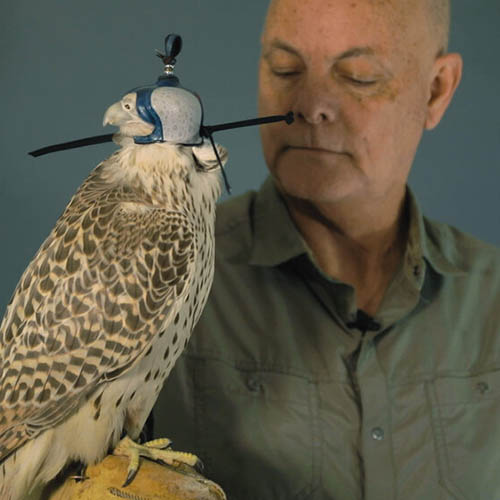
A Utah falconer, Steven Tait is a multifaceted artist skilled in painting, drawing, sculpture, and taxidermy. Tait emerged as a leading commercial hoodmaker in the 1990’s and his ongoing advancements in blocks (forms) attracted many other hood-makers who have since adopted his blocks. Tait used raptor skulls in the process of developing his new “beak blocks” and experimented with 3D scanning technology and CNC machining to further refine and reproduce them for the commercial market. Tait has produced an in-depth video on hoodmaking available through many falconry vendors.
-
Art Tawatari

Art was raised in southern California and following college became a dentist and settled in the Chico area where he primarily hawks pheasants with peregrines. He is notable for his willingness to share hoodmaking techniques and information to aspiring amateurs, and was influenced himself by Bob McCallum, Jack Stoddart, John Moran, and Clayton Smith. His hoods are known for their extremely tight, perfect stitching, closed seams, and close attention to the beak opening shape. His skill with dental materials and related hand tools no doubt contributed to his execution of fine detail work and ability to mold and pour his own blocks. Tawatari was an early innovator with varied synthetic materials for braces, adopting solutions that retained their integrity and closing resistance for the life of the hood.
-
Pete Watzke
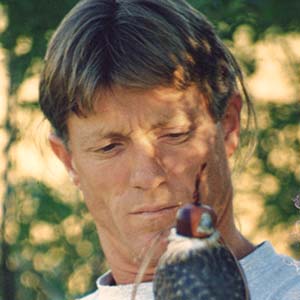
Originally a California falconer, the late Pete Watzke relocated to eastern Idaho where he primarily flew jack merlins. Pete was widely acclaimed for his merlin hoods despite extreme arthritis in his hands. Watzke was able to achieve a very lightweight, yet finely made merlin hood, with awe-inspiring stitching, that was also durable.
5. Modern Masters: 2000’s – Present
Through trial and error, innovation, and exchange, the “American Hood” evolved into a lightweight, durable, especially well-fitting molded hood, with an appropriately contoured beak opening, exemplifying a level perfection that seemed impossible to improve upon. Yet a new legion of both American and international hoodmakers have embraced much of these accomplishments and continue to rise on the ladder of success forged by their predecessors. With no traditions to restrain them, a new global community is still perfecting the “American Hood”.
A Selection of Contemporary Hoods
Note: Due to the limitations of space, and the hoods available in our scanned collection (at the time of this exhibit), we were not able to highlight the work of many gifted hoodmakers. We regret the current omission of many talented hoodmakers. The Archives of Falconry has a collection of over 800 hoods, however we have few examples of hoods made in the last decade, and/or examples from hoodmakers who emerged recently. Please consider donating hoods of contemporary makers worldwide, and we will update the final chapter of this exhibit!
If you would like to donate hoods from your collection, send the hood or hoods along with information on the maker, style, size, and materials to :
The Archives of Falconry
5668 W Flying Hawk Ln
Boise, ID 83709.
Have questions? Reach out to us at [email protected].
About this Exhibit
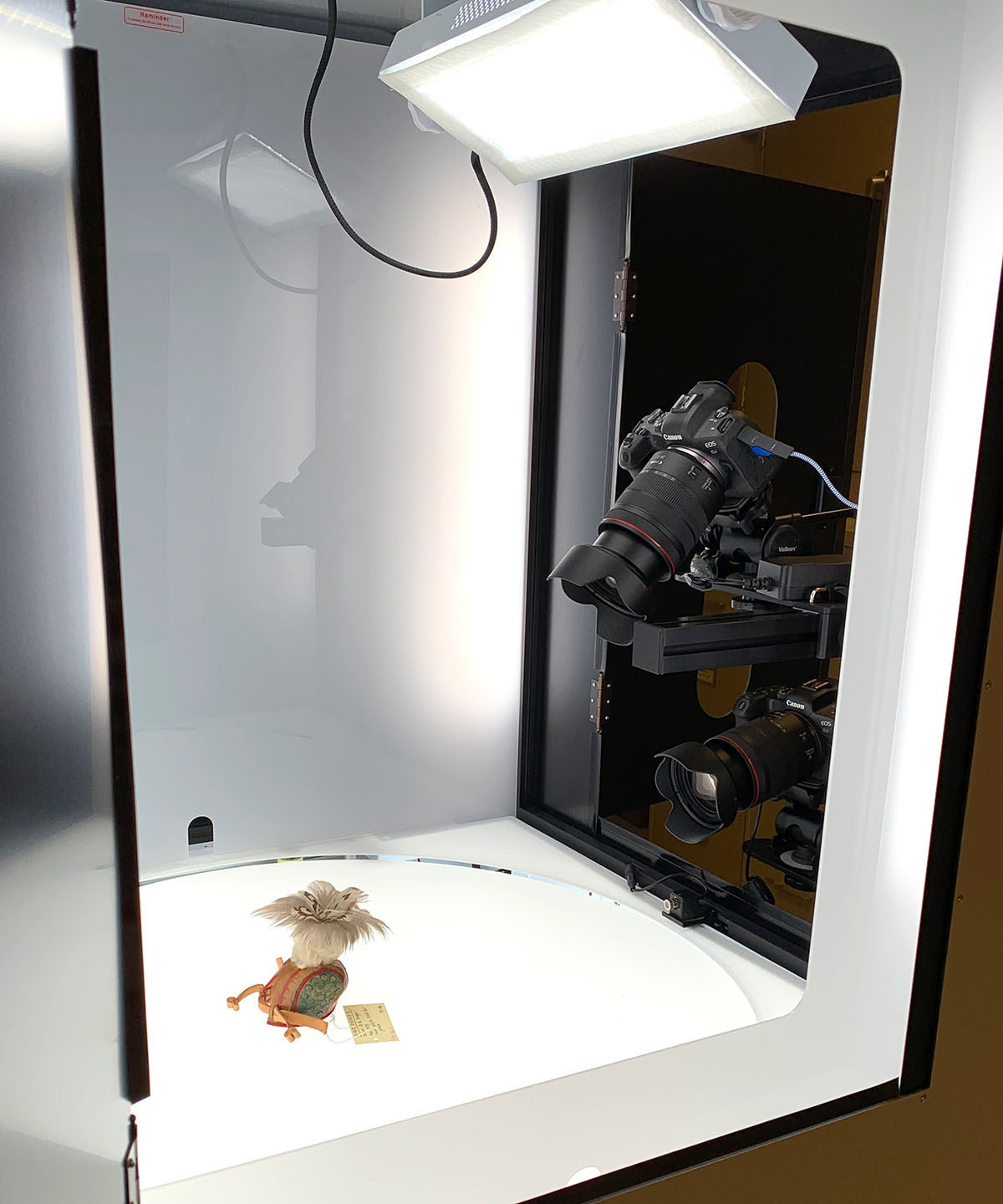
We encourage all falconers and interested parties to visit our facility in Boise and see these and many other hoods for themselves alongside thousands of other objects in our large collection. That said, we know that most people around the world will not be able to travel to Boise. Making our entire collection more accessible to a global audience is the primary motivation behind our new digitization effort.
Our digitization initiative will allow people to view all of our collection records and see photos of all of our artifacts. However, for the most special of objects, we wanted to find a digitization technology that generated an experience as close as possible to holding the object in your hand. We settled on 360° photography, and we thought a virtual exhibit on falconry hoods was a great way to introduce this technology. Each of our hoods is placed into our studio box where it is rotated and photographed 48 times by each of two cameras. The images are then stitched together on the computer, resulting in the high-resolution interactive elements you see throughout this exhibit.
You can learn more about our digitization process in episode one of our Ask the Curator video series.
These scans allow us to tell a story with our hoods. This narrative about the evolution of the American Hood is just one of the many stories we plan to share from our collection. As we digitize more content, we’ll deliver more stories and an experience that is the next best thing to being here yourself. If you enjoyed the exhibit, we hope you’ll share it with your friends using the share links below. And feel free to let us know what you think at [email protected]. What exhibits do you want us to develop? What are you most excited for us to scan?
Exhibit Curators
Kent Carnie, Curator Emeritus, The Archives of Falconry
John M. Goodell, Executive Director / Curator, The Archives of Falconry
James W. Nelson, Author of: Hoods, Hooding and Hoodmaking
Exhibit Designer and Multimedia Producer
Marc Dantzker, RangeWide Productions
